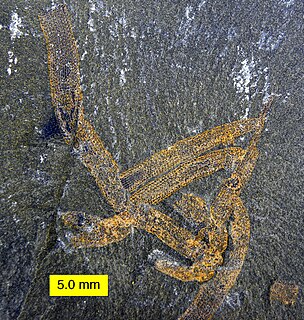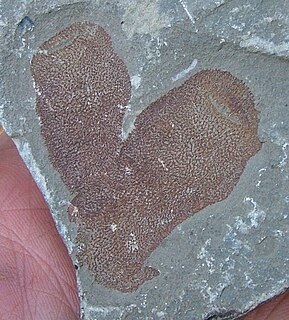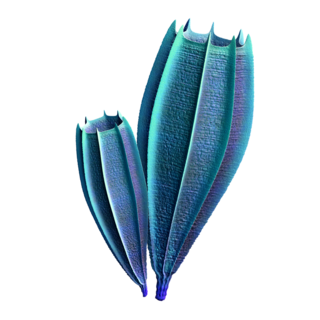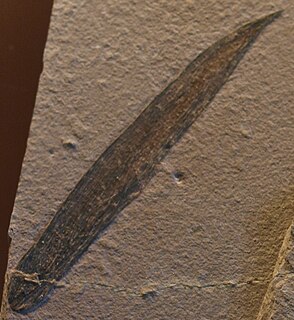
Vauxia is an extinct genus of demosponge that had a distinctive branching mode of growth. Each branch consisted of a network of strands. Vauxia also had a skeleton of spongin common to modern day sponges. Much like Choia and other sponges, Vauxia fed by extracting nutrients from the water.

Chancelloria is a genus of early animals known from the Middle Cambrian Burgess Shale, the Comley limestone, the Wheeler Shale, the Bright Angel Shale and elsewhere. It is named after Chancellor Peak. It was first described in 1920 by Charles Doolittle Walcott, who regarded them as one of the most primitive groups of sponges. This appears unlikely, and it is currently placed in the enigmatic group Coeloscleritophora. 178 specimens of Chancelloria are known from the Greater Phyllopod bed, where they comprise 0.34% of the community.
A number of assemblages bear fossil assemblages similar in character to that of the Burgess Shale. While many are also preserved in a similar fashion to the Burgess Shale, the term "Burgess Shale type fauna" covers assemblages based on taxonomic criteria only.
Crumillospongia is a genus of middle Cambrian sponges known from the Burgess Shale and other localities from the Lower and Middle Cambrian. Its name is derived from the Latin crumilla and spongia ("sponge"), a reflection of its similarity to a small leathery money purse. That is, it has a saclike shape, and its wall has holes of two sizes, with a well-developed internal canal system. 49 specimens of Crumillospongia are known from the Greater Phyllopod bed, where they comprise 0.1% of the community.

Hazelia is a genus of spicular Cambrian demosponge known from the Burgess Shale, the Marjum formation of Utah, and possibly Chengjiang. It was described by Charles Walcott in 1920.

Takakkawia is a genus of sponge in the order Protomonaxonida and the family Takakkawiidae. It is known from the Middle Cambrian Burgess Shale that reached around 4 cm in height. Its structure comprises four columns of multi-rayed, organic spicules that align to form flanges. The spicules form blade-like structures, ornamented with concentric rings.
Eiffelia is an extinct genus of sponges known from the Middle Cambrian Burgess Shale as well as several Early Cambrian small shelly fossil deposits. It is named after Eiffel Peak, which was itself named after the Eiffel Tower. It was first described in 1920 by Charles Doolittle Walcott. It belongs in the Hexactinellid stem group. 60 specimens of Eiffelia are known from the Greater Phyllopod bed, where they comprise 0.11% of the community.
Falospongia is a genus of sponge made up of radiating fronds, known from the Middle Cambrian Burgess Shale. Its name is derived from the Latin fala ("scaffold") and spongia ("sponge"), referring to the open framework of the skeleton. It superficially resembles Haplistion but is monaxial. 5 specimens of Falospongia are known from the Greater Phyllopod bed, where they comprise under 0.1% of the community.

Halichondrites is an extinct genus of sponge known from the Middle Cambrian Burgess Shale. 7 specimens of Halichondrites are known from the Greater Phyllopod bed, where they comprise < 0.1% of the community.
Hamptonia is a genus of sponge known from the Middle Cambrian Burgess Shale and the Lower Ordovician Fezouata formation. It was first described in 1920 by Charles Doolittle Walcott. 48 specimens of Hamptonia are known from the Greater Phyllopod bed, where they comprise < 0.1% of the community.
Leptomitus is a genus of demosponge known from the Middle Cambrian Burgess Shale. Its name is rerived from the Greek lept ("slender") and mitos ("thread"), referring to the overall shape of the sponge. 138 specimens of Leptomitus are known from the Greater Phyllopod bed, where they comprise 0.26% of the community.
Pirania is a genus of sponge known from the Middle Cambrian Burgess Shale and the Ordovician Fezouata formation. It is named after Mount St. Piran, a mountain situated in the Bow River Valley in Banff National Park, Alberta. It was first described in 1920 by Charles Doolittle Walcott. 198 specimens of Pirania are known from the Greater Phyllopod bed, where they comprise 0.38% of the community.
Protospongia is a genus of Porifera known from the Middle Cambrian Burgess Shale. 102 specimens of Protospongia are known from the Greater Phyllopod bed, where they comprise 0.19% of the community.
Wapkia is a genus of sponge with radial sclerites, known from the Middle Cambrian Burgess Shale. It was first described in 1920 by Charles Doolittle Walcott. 32 specimens of Wapkia are known from the Greater Phyllopod bed, where they comprise 0.06% of the community.
The Mount Stephen trilobite beds are a series of fossil strata on Mount Stephen, British Columbia that contain exceptionally preserved fossil material. Part of the same stratigraphic unit as the Burgess Shale, many non-mineralized parts are preserved; in addition, a high density of trilobite fossils is present.

The Hazeliidae are a family of spicular Cambrian demosponges known from the Burgess Shale, the Marjum Formation of Utah, and possibly Chengjiang. It was described by Charles Walcott in 1920.
Protoprisma is a genus of sponge known from the Burgess Shale.
Ulospongiella is a genus of sponge known only from the Burgess Shale. It contains only the species Ulospongiella ancyla.

Diagoniella is a genus of sponge known from the Middle Cambrian Burgess Shale. 128 specimens of Diagoniella are known from the Greater Phyllopod bed, where they comprise 0.24% of the community.
Protomonaxonida is an extinct order of demosponges. It is a paraphyletic group gathering the most ancient species from the Burgess Shale to modern sponges.







